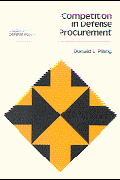In 1981 the Defense Department issued thirty-two “acquisition initiatives” aimed at improving the way federal government buys defense hardware. The thirty-second of these initiatives is increased competition, which was given the force of law in the Competition in Contracting Act (CICA) of 1984. This law places narrow restrictions on the awarding of noncompetitive government contracts, and mandates the appointment of Advocates for Competition in executive agencies. In Competition in Defense Procurement, Pilling examines the analytical basis for the strong belief in the advantages of competition, focusing primarily on its potential for reducing prices. He shows that the database commonly used for competition studies is inadequate and that the standard framework for analysis is flawed. Because of this, policymakers were faced with the dilemma of distinguishing anecdotal from systematic evidence on previous competition experiences. Pilling proposes an alternative model for analyzing competition–an approach that aligns the defense industry’s incentives more closely with the government’s best interests. Brookings Study in Defense Policy
Authors
